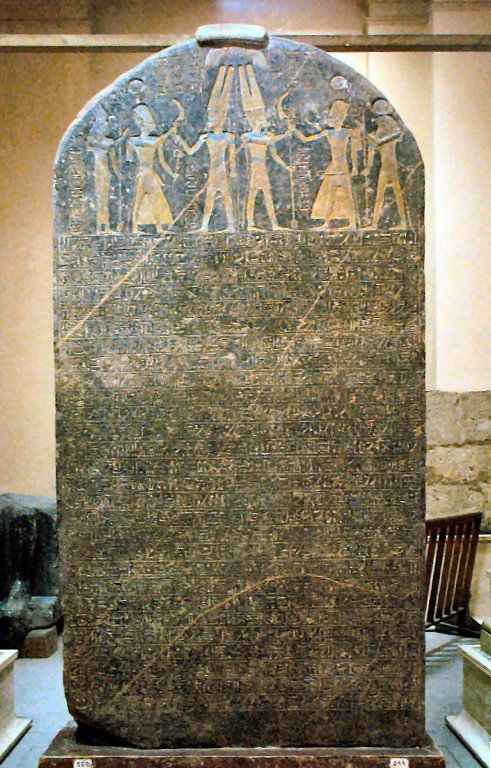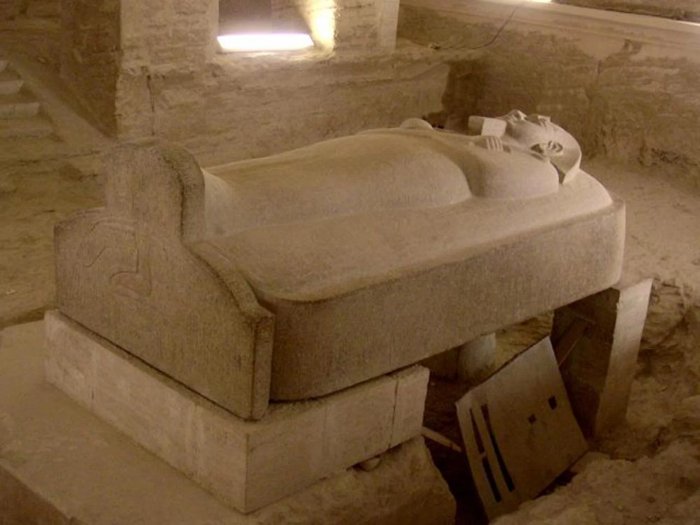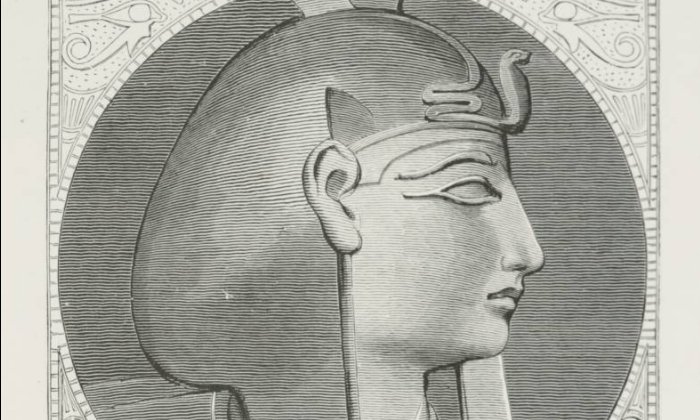Pharaoh Merneptah – His Giant Sarcophagus And Unique Victory Stele
A. Sutherland - AncientPages.com - Pharaoh Merneptah was Ramesses II’s 13th son. He succeeded his father when he was in his early sixties and reigned for ten years between 1213 B.C – 1203 B.C.
Greatly overshadowed by his dominant and long-lived father, Merneptah never had a chance to become a famous pharaoh, and he was almost unknown for most of his life. Yet, many Egyptologists believe that Merenptah was probably the real power behind the throne in the last decade of Ramesses II's life.
Merneptah makes an offering to Ptah on a column. Image credit: Chipdawes - Public Domain
In modern times, Pharaoh Merneptah has become famous for his extraordinary giant sarcophagus and unique Victory Stele, which offers the oldest evidence for Israel's existence in Canaan. However, some scholars disagree and say they have found even older evidence containing hieroglyphics that mention Israel.
Information about his military campaigns is documented on three great ancient inscriptions, including 80 lines on a wall in the Temple of Amun at Karnak, a large stele with 35 readable lines from Athribis in the Delta, and the great Victory Stele from his ruined mortuary temple at Thebes, with 28 lines.
Pharaoh Merneptah’s Victory Stele And Its Connection To Ancient Israel
Found in 1896, the Victory Stele became of great interest to Biblical scholars. Written in hieroglyphs, the text on the stele reads: "Canaan is plundered with every evil way. Ashkelon is conquered and brought away captive, Gezer seized, Yanoam made nonexistent; Israel is wasted, bare of seed."
Merneptah Stele known as the Israel stela (JE 31408) from the Egyptian Museum in Cairo. Credit: Webscribe - CC BY-SA 3.0
The ancient Egyptian inscription dates to about 1205 B.C. and recounts the military conquests of the pharaoh Merneptah. The Hebrews had conquered the land of Canaan around 1400 B.C.
Israel must have been of great importance to Pharaoh Merneptah because he wanted to memorize his victory. The discovery of the Stele of Pharaoh Merneptah led many scholars to believe this was the earliest mention of Israel.
However, Egyptologists and Biblical scholars Manfred Görg, Peter van der Veen and Christoffer Theis suggest that there may be an even earlier reference to Israel in the Egyptian record. Görg found a broken statue pedestal in the Egyptian Museum of Berlin containing hieroglyphic name-rings.
A study of the ancient Egyptian artifact revealed that one of the name rings should be read as “Israel.” Not all Biblical scholars agree with this interpretation, but if Görg is correct, the Egyptian statue in the Museum of Berlin is the oldest discovered reference to Israel. The inscription examined by Görg is dated around 1400 B.C.E.—about 200 years earlier than the Merneptah Stele.
Pharoah Merneptah’s Huge Sarcophagus - The Largest Ever Discovered In Egypt
Pharaoh Merneptah may not have been a famous ruler. Still, he certainly did receive an extraordinary burial box decorated with illustrations from Egyptian books of the afterlife that describe the sun god’s journey into the realm of the dead.
The lid of the second sarcophagus bearing an image of Merneptah. This would have been completely enclosed by the outer sarcophagus box and lid. Credit: Hajor - source
Some years ago, archaeologists discovered the largest ancient Egyptian sarcophagus in a tomb in the Valley of the Kings. It belonged to Pharaoh Merneptah.
He was buried in four nested stone sarcophagi! According to researchers and conservators at the Royal Ontario Museum in Toronto, Pharaoh Merneptah’s mummy was placed within a series of four nested sarcophagi, the outermost of which measures 13 feet long, 7 feet wide, and more than 8 feet tall.
Project director Edwin Brock, a research associate at the Royal Ontario Museum in Toronto, explained that the sarcophagi box was so large that workers could not get it through the door. Ultimately, they had to destroy the chamber's door jams and build new ones.
Imaginary portrait of Merenptah in a nineteenth-century engraving. Image credit: Burger, Ludwig -CC BY-SA 2.5
Evidence of this can be seen on the holes in the entrance shaft to the tomb that indicating a pulley system of sorts, with ropes and wooden beams workers must have used to bring the sarcophagi in.
According to Biblical Archaeology Review, “when Brock examined the tomb remains in the 1980s, fragments of the two outer sarcophagi were simply piled up in a side chamber. The two granite boxes had been smashed to pieces in antiquity following a tomb robbery more than 3,000 years ago. At that time, Merneptah’s mummy was reburied, and the second inner sarcophagus was reused by a later ruler. The third sarcophagus was topped with an oval cartouche-shaped lid depicting Merneptah. Only a third of the outermost sarcophagus remains (in fragments), but its lid is intact.”
Why was Pharaoh Merneptah, who was not a famous ruler, put to rest in such a large sarcophagus? This is a question no one has yet been able to answer. For some reason, Pharaoh Merneptah’s burial boxes were far more elaborate than his father’s and grandfather’s.
Scientists suggest it’s possible that Merneptah needed a box with large surfaces to depict the extensive ritual illustrations and magical spells that are repeated numerous times across the four sarcophagi.
Updated on January 7, 2024
Written by – A. Sutherland AncientPages.com Staff Writer
Copyright © AncientPages.com All rights reserved. This material may not be published, broadcast, rewritten or redistributed in whole or part without the express written permission of AncientPages.com
Expand for referencesManassa, Colleen. In The Great Karnak Inscription of Merneptah: Grand Strategy in the 13th Century BC, V-Vi.
Biblical Archaeology Review 39:3, May/June 2013 - Strata: Pharaoh Merneptah’s Massive Burial Box
More From Ancient Pages
-
 Face Of A Greek Girl That Lived 9,000-Years Ago Reconstructed In Athens
Archaeology | Jan 27, 2018
Face Of A Greek Girl That Lived 9,000-Years Ago Reconstructed In Athens
Archaeology | Jan 27, 2018 -
 Nomadic People’s 1,500-Year-Old Imperial Worship Unearthed In Hohhot, Inner Mongolia
Archaeology | Nov 18, 2020
Nomadic People’s 1,500-Year-Old Imperial Worship Unearthed In Hohhot, Inner Mongolia
Archaeology | Nov 18, 2020 -
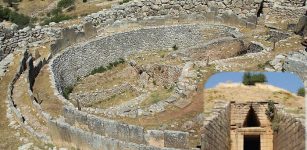 Mycenae Kingdom: Home To King Agamemnon And Tholos Tomb ‘Treasure of Atreus’
Civilizations | Jun 11, 2022
Mycenae Kingdom: Home To King Agamemnon And Tholos Tomb ‘Treasure of Atreus’
Civilizations | Jun 11, 2022 -
 New Clues Why Neanderthals Visited La Cotte de St Brelade In Jersey 250,000 Years Ago
Archaeology | Jun 18, 2023
New Clues Why Neanderthals Visited La Cotte de St Brelade In Jersey 250,000 Years Ago
Archaeology | Jun 18, 2023 -
 Underwater City: Unveiling The Secrets At The Bottom Of Fuxian Lake
Ancient Mysteries | Jun 13, 2015
Underwater City: Unveiling The Secrets At The Bottom Of Fuxian Lake
Ancient Mysteries | Jun 13, 2015 -
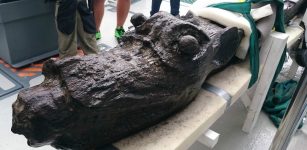 Mystery Of Gribshunden – Danish Royal Sunken Ship Sheds New Light On Psychological Warfare In The Middle Ages
Archaeology | Apr 14, 2017
Mystery Of Gribshunden – Danish Royal Sunken Ship Sheds New Light On Psychological Warfare In The Middle Ages
Archaeology | Apr 14, 2017 -
 Stone Slab c. 9,000-Year-Old Used In Making Fire Discovered Not Far From Jerusalem, Israel
Archaeology | May 17, 2017
Stone Slab c. 9,000-Year-Old Used In Making Fire Discovered Not Far From Jerusalem, Israel
Archaeology | May 17, 2017 -
 Amazing World’s Largest Mosaic Piece Made By 13 Different Ancient Civilizations At Museum Hotel Antakya
Featured Stories | May 9, 2019
Amazing World’s Largest Mosaic Piece Made By 13 Different Ancient Civilizations At Museum Hotel Antakya
Featured Stories | May 9, 2019 -
 Teens Make Incredible Discovery In An Ancient Florida Cave
Featured Stories | Mar 15, 2024
Teens Make Incredible Discovery In An Ancient Florida Cave
Featured Stories | Mar 15, 2024 -
 Oxford University Is Older Than The Aztec Empire – Historical Records Say
Ancient History Facts | Dec 5, 2017
Oxford University Is Older Than The Aztec Empire – Historical Records Say
Ancient History Facts | Dec 5, 2017 -
 Tipón (Tipon): Who Taught The Inca How To Build Artificially Irrigated Garden?
Ancient Technology | May 1, 2019
Tipón (Tipon): Who Taught The Inca How To Build Artificially Irrigated Garden?
Ancient Technology | May 1, 2019 -
 How Pre-Industrial Communities in Northeastern Europe Adapted to Climate Changes Over the Past Two Millennia
Archaeology | Feb 3, 2025
How Pre-Industrial Communities in Northeastern Europe Adapted to Climate Changes Over the Past Two Millennia
Archaeology | Feb 3, 2025 -
 King Tutankhamun’s Large Golden Coffin Was Moved For Restoration
Archaeology | Jul 18, 2019
King Tutankhamun’s Large Golden Coffin Was Moved For Restoration
Archaeology | Jul 18, 2019 -
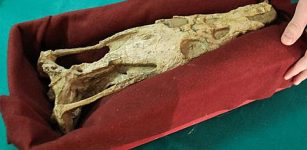 More Than 1000 Bones Of Extinct Predators From 240 Million Years Ago – Found In Upper Silesia, Poland
Fossils | Dec 11, 2023
More Than 1000 Bones Of Extinct Predators From 240 Million Years Ago – Found In Upper Silesia, Poland
Fossils | Dec 11, 2023 -
 Skofnung – Formidable Sword With Supernatural Powers That Belonged To Legendary Danish King Hrólf Kraki
Featured Stories | Mar 3, 2018
Skofnung – Formidable Sword With Supernatural Powers That Belonged To Legendary Danish King Hrólf Kraki
Featured Stories | Mar 3, 2018 -
 Ancient DNA Reveals A Diverse Community Lived At Machu Picchu, The ‘Lost City Of The Incas’
Archaeology | Jul 26, 2023
Ancient DNA Reveals A Diverse Community Lived At Machu Picchu, The ‘Lost City Of The Incas’
Archaeology | Jul 26, 2023 -
 Ancient Secrets Of Karelia: Mysterious Vottovaara Mountain Was Sacred To The Sami People
Featured Stories | Apr 5, 2017
Ancient Secrets Of Karelia: Mysterious Vottovaara Mountain Was Sacred To The Sami People
Featured Stories | Apr 5, 2017 -
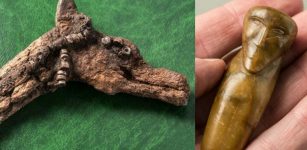 Ancient Doll And Mythical Animal – 4,500-Year-Old Toys Discovered In Siberia
Archaeology | Dec 30, 2017
Ancient Doll And Mythical Animal – 4,500-Year-Old Toys Discovered In Siberia
Archaeology | Dec 30, 2017 -
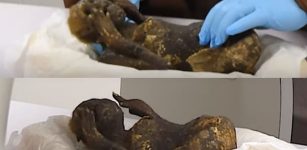 Mysterious Mermaid Mummy Investigated By Scientists
News | Feb 22, 2022
Mysterious Mermaid Mummy Investigated By Scientists
News | Feb 22, 2022 -
 Mystery Of Vangchhia Ancient Site: Water Pavilion And Ingenious Idea Of Water Harvesting
Archaeology | Feb 21, 2019
Mystery Of Vangchhia Ancient Site: Water Pavilion And Ingenious Idea Of Water Harvesting
Archaeology | Feb 21, 2019


